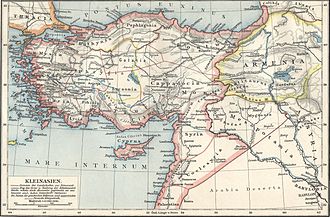Paphlagonia
Paphlagonia is the ancient name of a landscape on the Black Sea , on the central north coast of Asia Minor with an area of about 100 × 400 km. It bordered Bithynia to the west, Pontus to the east, and Phrygia and Cappadocia to the south . According to ancient tradition, the Greek name Paphlagonia comes from the tribe of the Paphlagonians , from which the Eneti / Veneti supposedly emerged . It is unclear whether the name of the Palaer was included in the ancient name.
history
Around 2000 BC The Hattier principality existed in Anatolia . They were replaced by Indo-Europeans , whose migration brought some peoples here: the Palaer people settled in Paphlagonia, the Hittites and Luwians in central and southern Anatolia. Whether also from the 15th century BC Chr. In Hittite sources mentioned Kaškäer resident in Paphlagonia are native or immigrated, is controversial. Little by little, principalities emerged (1660–1460 BC), from which, among other things, the great empire of the Hittites (1460–1190 BC) emerged. It was organized as a federative feudal state and about 1259 concluded the first written peace treaty in history with Egypt , the second superpower of the age (see Egyptian-Hittite peace treaty ).
At the latest in the 7th century BC Especially Greek Ionians from Miletus began to settle on the Black Sea coast. Trade contacts between Greeks and residents of northern Anatolia had already existed for a long time. Around 500 BC The south of the area was annexed to the Persian Empire and later part of the Kingdom of Pontus . The coastal region came to the Roman Empire through Pompey . Its strongest opponent was the Pontic king Mithridates VI. Eupator (121–63 BC), who did not rule Rome until 85 BC. BC lost after several wars.
In 64 BC In BC Pompey founded seven new cities in the interior, which was formerly characterized by small principalities, and united the region with Bithynia to form the province of Bithynia et Pontus . The most important of the new cities was Pompeiopolis , which remained the political and economic center of central Paphlagonia until the early Middle Ages. The most important city on the coast and the only good port was Sinope .
In addition to Pontus, Asia Minor was now divided into the province of Syria in the east and Cilicia ( Cilicia ) in the south. The kings of Paphlagonia as well as of Galatia , Cappadocia and Commagene retained their throne as vassals of Rome and as a “buffer” against neighboring peoples. Only with Augustus and his "Pax Romana" began a heyday at the turn of the ages, which lasted until Emperors Trajan and Hadrian in the 2nd century AD. During the administrative reform of Emperor Diocletian in 295, the province of Bithynia et Pontus was divided into the provinces of Bithynia , Paphlagonia and Diospontus , and in 384/7 parts of Paphlagonia were made the new province of Honorias .
Paphlagonia was part of the Byzantine Empire from late antiquity until it fell to the Trebizond Empire in the early 13th century and later to the Turks . The advance of the Turkmen Seljuks began in the 11th century and brought them almost all of Anatolia after the Battle of Manzikert in 1071 . The center of the empire of the Rum Seljuks was Iconium (today's Konya ) in the south.
With the onslaught of the Mongols in the middle of the 13th century, the Seljuq Empire split up into many principalities, the so-called Beyliks . One of their dynasties, named the Ottomans after their leader Osman I , conquered the surrounding areas and took Byzantine Bursa in 1326 . In the Ottoman Empire, Paphlagonia finally lost its autonomy and its historical name.
Most important cities
- Gangra ( Kiankari )
- Hadrianopolis
- Kastamon ( Kastamonu )
- Kytoros (Kidros)
- Pompeiopolis
- Sesamos, later Amastris ( Amasra )
- Sinope ( Sinop )
- Stephane (Istifan)
Roman auxiliary units
During the Roman Empire , the following auxiliary units were recruited in the Paphlagon region:
literature
- Klaus Belke : Paphlagonia and Honōrias (= Tabula Imperii Byzantini 9 = Austrian Academy of Sciences. Philosophical-Historical Class. Memoranda 249). Publishing house of the Austrian Academy of Sciences, Vienna 1996, ISBN 3-7001-2518-6 .
- Christian Marek : History of Asia Minor in Antiquity. CH Beck, Munich 2010, ISBN 978-3-406-59853-1 , p. 920 (index, see Paphlagonien / Paphlagonier ).
Individual evidence
- ^ AJ Graham : The date of the Greek penetration of the Black Sea. In: Bulletin of the Institute of Classical Studies. Vol. 5, No. 1, 1958, pp. 25-42, doi : 10.1111 / j.2041-5370.1958.tb00610.x .
Coordinates: 41 ° 36 ' N , 35 ° 0' E




